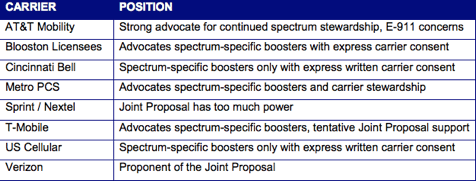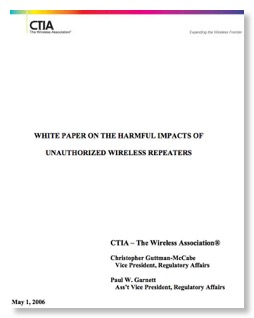Docket 10-4: 6+ Years of FCC Inaction Turns an Emerging Interference Issue into a "Lose/Lose" Situation
On November 2, 2007, CTIA, the Wireless Association (CTIA) filed a Petition for Declaratory Ruling (CTIA Petition) regarding the proper use of signal boosters in Commercial Mobile Radio Services (CMRS).
Hence there was no explanation for the over 2 year delay in responding to this petition from a very powerful trade association. If a trade group as powerful as CTIA can be ignored for 2+ years, one wonders how much attention a mere startup company would get? Since the 1st Amendment guarantees the right “to petition the Government for a redress of grievances” and the APA reiterates this right, "Each agency shall give an interested person the right to petition for the issuance, amendment, or repeal of a rule" (5 USC 553(e)), it is puzzling that FCC in recent decades have given most petitions such little attention. When Bob Foosaner was head of WTB’s predecessor in the 1980s, he argued pragmatically that petitions had to be either dismissed or put out for public comment in about a month, for otherwise the embarrassment of inaction impacts the real options.
(While the delay from the filing of the petition to the FCC PN was 26 months, the petition included as an attachment a “WHITE PAPER ON THE HARMFUL IMPACTS OF UNAUTHORIZED WIRELESS REPEATERS” that had been submitted to FCC on May 1, 2006! Thus CTIA had formally contacted FCC about the interference from bidirectional amplifiers almost 4 years before FCC took any public action, such as asking for comments, on this issue! Below is a section heading from the CTIA 2006 white paper)
![]()
Unfortunately CTIA’s documents failed to recognize that although early amplifiers sometimes caused interference, they were also of real benefit to consumers who suffered from marginal cellular coverage especially in rural areas. They also were very popular among public safety users, although they also complained about interference from early models (still permitted due to the impasse in this proceeding). Thus the total prohibition of amplifiers that CTIA sought was unreasonable, although it took a long time for key CTIA members to come to this realization.
We have argued here previously that emerging interference issues are inevitable in the dynamic wireless area and need to be addressed and “nipped in the bud” before they get worse. The 10+ year delay of dealing with police radar detector interference to VSAT terminals is an example of ignoring a problem until it becomes unmanageable and then putting burdens on all involved to solve it. (FCC has never even acknowledged publicly that it was aware of this problem for 10+ years before taking action!)
So what has happened in the 6+ years since CTIA’s white paper was filed? Since there has been no regulation adopted to address the issue of amplifiers that oscillate like PA systems with a microphone too close to the speaker, low end manufacturers still sell such amplifiers in the US market and presumably continue to cause interference. High end US-based manufacturers have switched to designs that are protected from oscillations and do not cause this interference - although the present designs they might cause much less frequent problems through more obscure mechanisms. However, due to regulatory inaction by FCC, low end manufacturers can continue to sell early generation units that can and do oscillate and cause interference to cellular systems.
So,
- Cellular operators continue to get interference from existing and new amplifiers that come from low end manufacturers and which continue to be legal in the current regulatory impasse.
- Legitimate amplifier manufacturers with updated designs that don’t oscillate suffer price competition from low end makers who undersell them with equipment that threatens cellular systems AND during the pendency of this rulemaking have limited access to new capital for improved equipment design due to regulatory uncertainty during the tendency of this proceeding. At least one of these manufacturers actually makes the units in a small US town in a “red state”. One new US entrant who contacted me several years ago about entering the market with an oscillation-protected design never got the financing he needed - probably due to regulatory uncertainty.
A true “lose/lose” situation! Due to the deadlock both sides (as well as the public) suffer!
Meanwhile the CTIA membership can’t make up its mind what the powerhouse should press for and meanders like a rudderless ship. A recent filing has a table summarizing the positions of the various carriers with respect to the “Joint Proposal” of Verizon Wireless and Wilson Electronics for reasonable regulation of amplifiers.

Comparison of carrier positions from Millard/Raines Partnership 5/12 filing
What is needed here is some real leadership either in the cellular industry or at FCC. While reasonable people can disagree on the best solution, most will agree that a solution is in everyone’s interest. Perhaps FCC should send an ultimatum to the industry to come up with a unified position within 2 months or else FCC will moved directly to a decision based on the current record.
It is nice to try to be everyone’s friend, but that is not a good way to run a regulatory agency in a fast moving technical area. Some times you just have to make a decision and move on.
It has been over 6 years since CTIA said
![]()
Now is the time for action! This problem is not “rocket science”, rather the impasse reflects a basic problem in FCC spectrum policy: an unwillingness to tackle basic Title III issues that are part of the Commission’s basic charter.
If the FCC IG had a good understanding of his role, he would investigate how this mess developed at FCC so the Commission can learn from these events. Don’t hold your breath, though.
So let me make a modest suggestion to resolve this impasse:
In effect the Commission is now using an informal nontransparent version of negotiated rulemaking (neg/reg) to resolve this problem. It is waiting for the parities to reach consensus - they aren’t.
As I indicated previously, while neg/reg has been successful in Executive Branch agencies, it has never been successful at FCC. I believe the reason is that neg/reg depends on a fear by all affected parties involved that the agencies will quickly make its own decision if negotiations fail to reach a consensus. In a multimember commission like FCC the parties generally feel they can just take an impasse to the 8th Floor and start all over again. Thus I propose that the Commission quickly convert this proceeding to a formal negotiated rulemaking one with a short time frame, say 60 days AND delegate, pursuant to Section 5(c) of the Communications Act, the authority to issue an NPRM and a Report & Order to one commissioner who is solely responsible for the negotiated rulemaking. Thus the neg/reg committee members will see that escalating the issue to 8th Floor politics is pointless and it is time to make real concessions while the issue is under their control. Hopefully just deciding to act this way may pressure the parties involved to reach a timely consensus without the formality of neg/reg and lead directly to timely resolution of these issues.
This type of issue should not take more than 6 years to resolve! The delay highlights a major problem in Title III policy development at FCC: an unwillingness to make timely decisions on the bread and butter issues that are necessary for efficient spectrum policy. If the commissioners would like to spend their time on grander issues, they should develop alternatives to deal with these issues. Section 5(c) gives they great flexibility in improving FCC throughput. Resolving all issues with 5 presidential appointees is not really practical in today’s complex environment.
When FCC first met in 1935, it created 3 parallel committees of (the then 7) commissioners (called “divisions” at the time) so the 3 committees could work in parallel. Today’s industry and technology is much more complex than in 1935 and the 1946 APA makes decision making much more complex. The delay in this proceeding shows that the present structure just isn’t working and all parties are suffering as a result.





![Validate my RSS feed [Valid RSS]](valid-rss-rogers.png)

